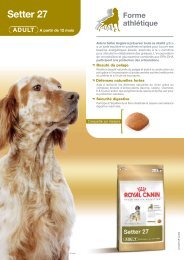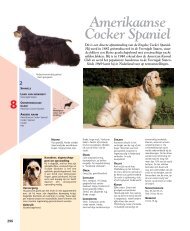Specific breed brochure - Breed Nutrition
Specific breed brochure - Breed Nutrition
Specific breed brochure - Breed Nutrition
Create successful ePaper yourself
Turn your PDF publications into a flip-book with our unique Google optimized e-Paper software.
1. Ulna<br />
2. Radius<br />
3. Process Medial coronoid<br />
4. Humerus<br />
A skeleton that needs protecting<br />
Weighing in often at more than 40 kg – even females – the Rottweiler is halfway between the large<br />
and giant <strong>breed</strong>s. Its particular conformation means that its joints are subjected to major mechanical<br />
pressure. Visits to the veterinarian due to limping are not uncommon as the Rottweiler’s joints are<br />
very susceptible to diseases commonly affecting large dogs. Good management of physical activity<br />
and diet is vital to keep the skeleton healthy.<br />
Fragmentation of the coronoid<br />
medial process<br />
Fragmentation of the medial<br />
coronoid process is an<br />
example of elbow dysplasia,<br />
a disease that often affects<br />
Rottweilers<br />
(Swenson et al, 1997).<br />
10<br />
Forequarters<br />
The most common complaints in the forelimbs<br />
relate to the elbow joint (Weinstein et al, 1995).<br />
In puppies, these are generally primary lesions,<br />
such as osteochondritis* due to an ossification<br />
problem in growth cartilage or fragmentation of<br />
the ulna (one of the bones in the forelimbs),<br />
known as the medial coronoid process. In older<br />
dogs, the source of pain can be secondary<br />
arthritis lesions. Males appear to be more often<br />
affected than females (Grondalen and Lingaas,<br />
1991).<br />
In 19% of cases of a chronic limp in one of the<br />
front legs, the diagnosis is a bone tumour, generally<br />
an osteosarcoma, causing the proliferation<br />
of abnormal bone tissue. Compared with the<br />
general dog population Rottweilers are 4.6 times<br />
more at risk of this type of disease (Langebach et<br />
al, 1998).
















